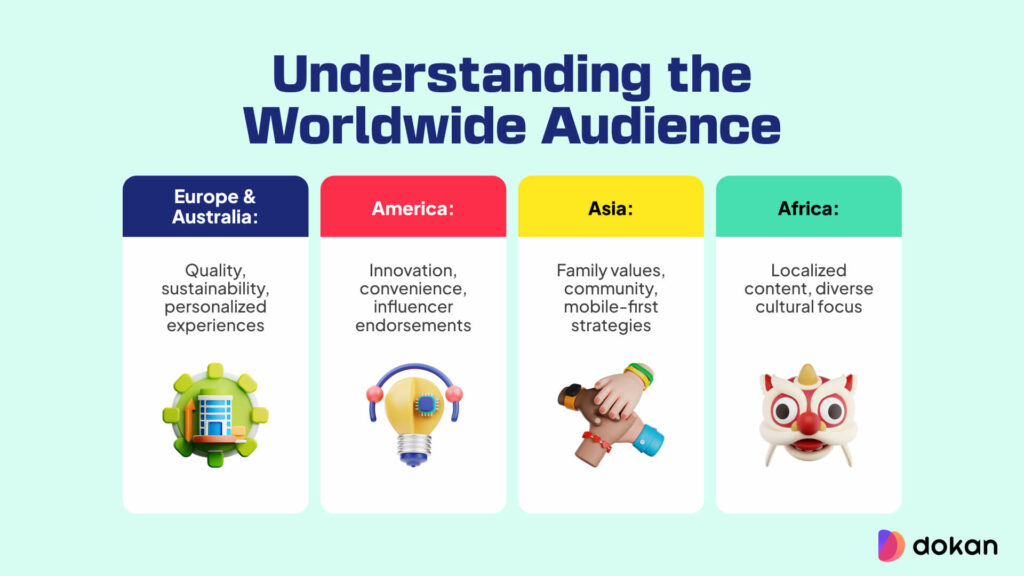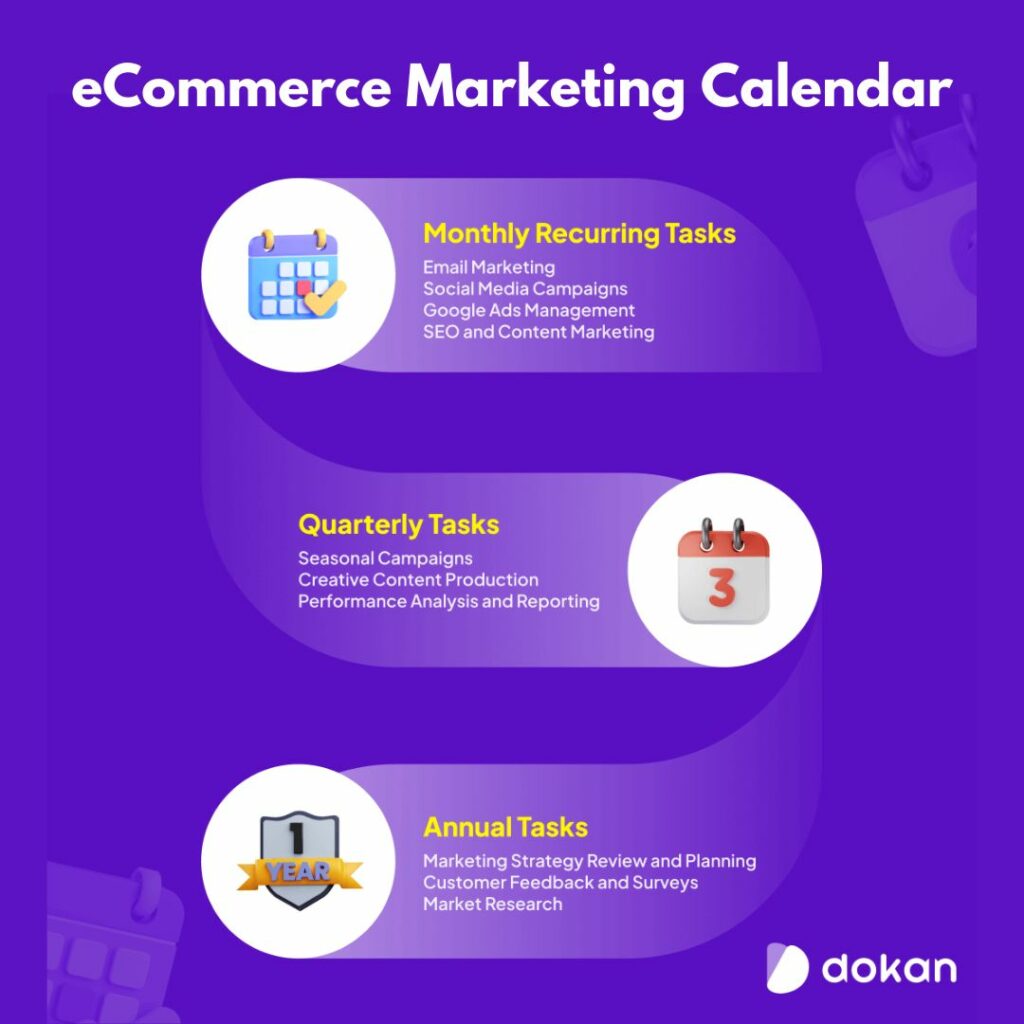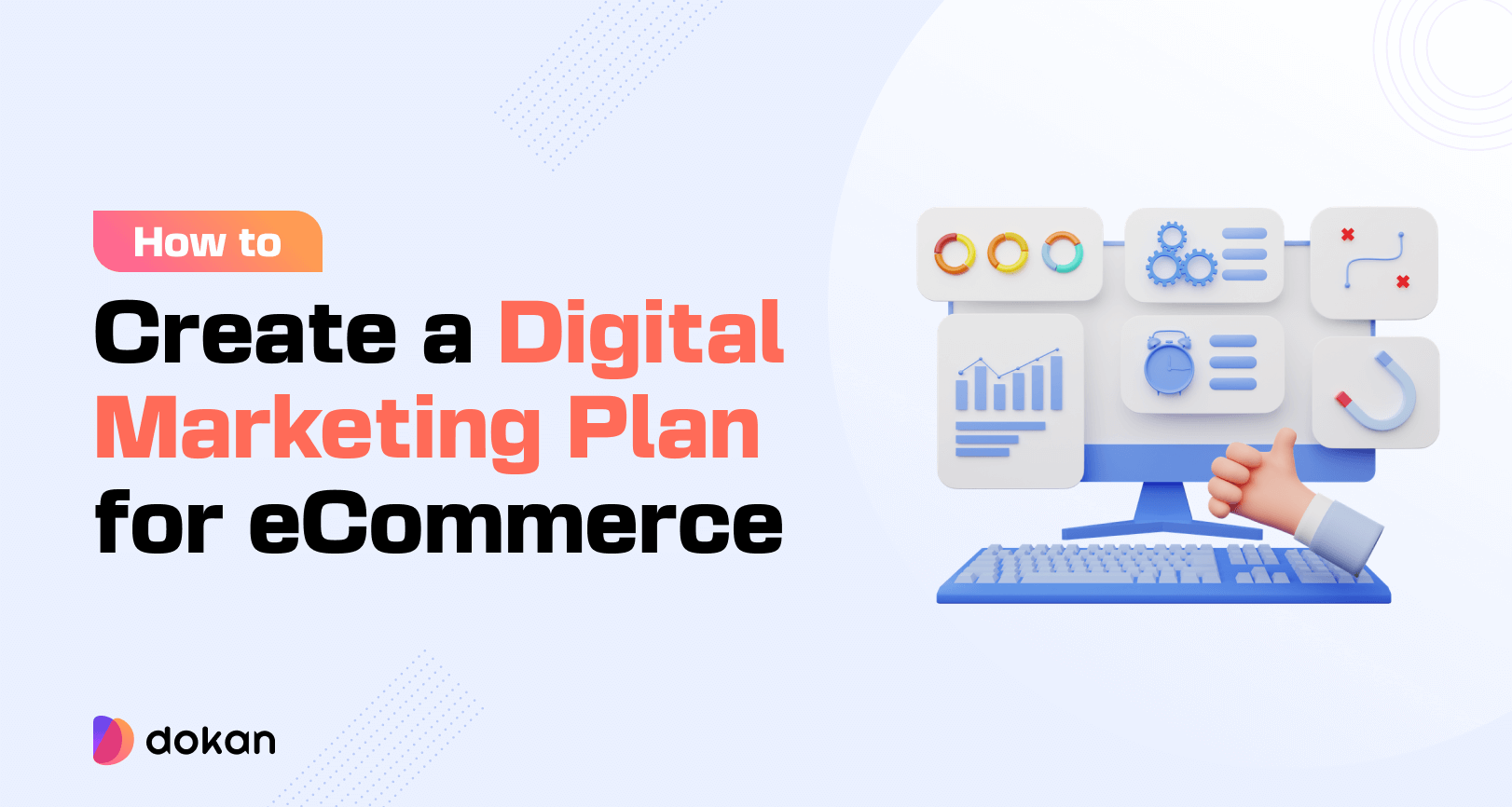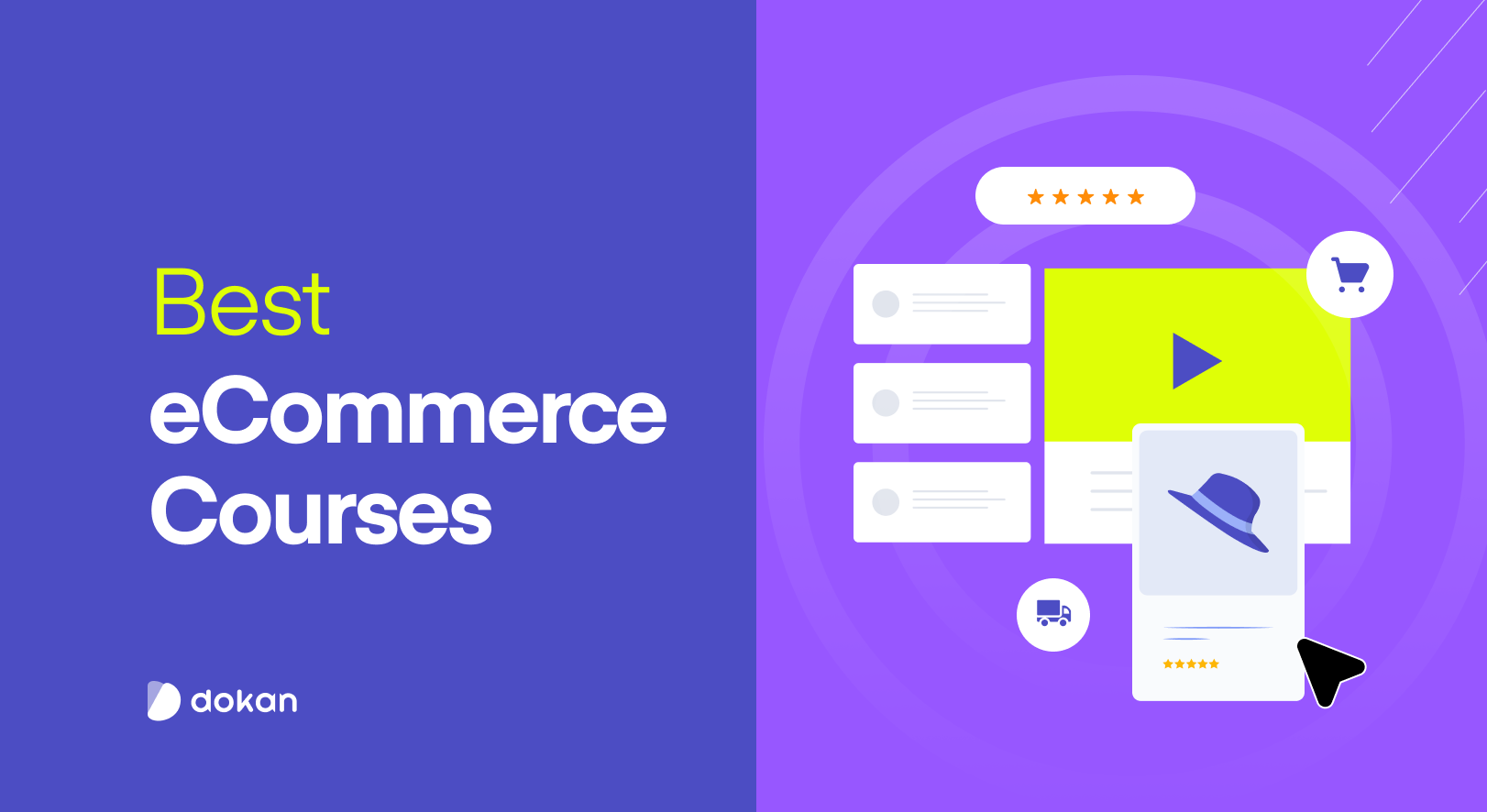With over 10 years of experience, we have developed and refined a digital marketing plan for eCommerce. This plan is particularly useful for small and medium eCommerce business owners looking to optimize their marketing efforts and achieve sustainable growth.
What is an eCommerce Marketing Plan?
An eCommerce marketing plan outlines how a business intends to drive traffic to its website and convert visitors into customers.
It includes strategies to attract, convert, and retain customers using various marketing channels. Also ensures alignment with the overall business vision and goals.
The main goals of eCommerce Marketing are-
- Increase Website Traffic
- Boost Conversion Rates
- Enhance Customer Retention
- Expand Email Subscriber List
- Improve Average Order Value
- Increase Social Media Engagement
- Improve Customer Lifetime Value
Let’s show you all the essential steps to create a digital marketing plan:
Practical Steps to Create a Digital Marketing Plan for eCommerce
- Define Clear Digital Marketing Goals
- Consider the eCommerce Buyer’s Journey
- Choose the Right Digital Channels
- Prepare an eCommerce Marketing Calendar
- eCommerce Marketing Budget & Cost
- Leverage Data and Analytics
Rather than relying solely on theoretical or collected information, our approach integrates a pragmatic and realistic plan. This ensures that businesses of all types can readily grasp and implement these strategies to achieve their goals effectively.
1. Define Clear Digital Marketing Goals
Establishing SMART (Specific, Measurable, Attainable, Realistic, Time-bound) goals is crucial.
For instance, instead of a vague objective like “increase sales,” set a specific target such as “gain 1,000 new leads in 90 days”.
Defining clear goals and budget allocation is essential for an effective marketing strategy. Allocate your budget evenly between paid marketing and organic efforts, ideally following a 50/50 split.
However, remain flexible to adjust this allocation based on the performance metrics from Google Ads and other social media platforms. Monitor the effectiveness of each channel closely and be prepared to reallocate funds to optimize your marketing efforts and achieve your goals efficiently.
2. Consider the eCommerce Buyer’s Journey
Understand how your customers move through the sales funnel—from awareness to consideration to conversion. Allocate the budget to engage with potential customers at each stage effectively.

The buyer’s journey can vary significantly based on location. Such as-
- In Europe, emphasizing quality, sustainability, and personalized experiences resonates well with consumers who value reliability and cultural diversity.
- In America, highlighting innovation and convenience, and using influencer endorsements can capture the attention of digitally-engaged consumers.
- In Asia, focusing on family values, community, and mobile-first strategies aligns with preferences for tradition and social status.
- In Africa, where digital adoption is growing, localized content and addressing the continent’s diverse cultural and linguistic landscape are essential for engaging with the expanding online audience.
Create detailed buyer personas to understand your target audience’s demographics, interests, and behaviors. This helps you meet the specific needs and preferences of different customer segments.
3. Choose the Right Digital Channels
Select digital marketing channels based on your target audience’s online behavior. For example, Gen Z can be effectively reached on TikTok and Instagram, whereas older demographics may be more active on Facebook and LinkedIn.
An omnichannel approach ensures a cohesive customer journey across multiple platforms.
The preference for social channels can also vary based on different locations and cultural contexts. Such as-
- In Europe, platforms like Facebook, Instagram, and LinkedIn dominate, with Facebook serving as a cornerstone for broad audience engagement, Instagram appealing to younger demographics, and LinkedIn facilitating professional networking.
- In America, Facebook, Instagram, Twitter, and YouTube are widely used, each catering to different content preferences and demographics, from real-time updates on Twitter to video-centric content on YouTube.
- Asia showcases diversity with platforms like WeChat in China for comprehensive social interaction and Line in Japan for messaging, while Southeast Asia favors a mix of Facebook, Instagram, and YouTube.
- Africa is experiencing rapid growth in social media adoption, with Facebook leading due to its expansive reach and appeal across diverse demographics.
Understanding these regional preferences helps businesses effectively leverage digital channels to reach their target audiences and achieve marketing objectives.
4. Prepare an eCommerce Marketing Calendar
A well-structured eCommerce marketing calendar is crucial for planning and executing effective marketing campaigns throughout the year. It helps in aligning marketing activities with key dates, holidays, and sales events to maximize customer engagement and sales.
This calendar provides a detailed schedule of marketing initiatives, ensuring that your team stays organized and that all opportunities to connect with your audience are strategically leveraged for optimal impact.

Monthly Recurring Tasks
- Email Marketing:
- Weekly newsletters with promotions, product highlights, and special offers.
- Monthly segmentation and personalization updates.
- Social Media Campaigns:
- Weekly content posts on Facebook, Instagram, Pinterest, and Twitter.
- Monthly social media contests and giveaways.
- Google Ads Management:
- Weekly performance reviews and optimization.
- Monthly budget reallocation based on performance metrics.
- SEO and Content Marketing:
- Weekly blog posts and product-related articles.
- Monthly keyword research and SEO audits.
Quarterly Tasks
- Seasonal Campaigns:
- Plan and launch campaigns for major holidays (e.g., New Year, Easter, Summer, Black Friday, Christmas).
- Design and promote seasonal products and offers.
- Creative Content Production:
- Quarterly production of new promo videos and high-quality visuals.
- Update website banners and ad creatives.
- Performance Analysis and Reporting:
- Comprehensive review of all marketing channels.
- Adjust strategies based on ROI analysis.
Annual Tasks
- Marketing Strategy Review and Planning:
- Annual review of marketing goals and achievements.
- Develop and set new targets for the upcoming year.
- Customer Feedback and Surveys:
- Conduct annual customer satisfaction surveys.
- Implement feedback to improve products and services.
- Market Research:
- Analyze market trends and competitor strategies.
- Identify new opportunities and threats.
This calendar ensures continuous engagement with your audience while optimizing marketing efforts to boost sales and ROI throughout the year.
5. eCommerce Marketing Budget & Cost
Allocate your digital marketing budget across different channels based on their effectiveness and potential ROI. Monitor and adjust spending as needed to optimize performance.
In allocating our $200,000 eCommerce marketing budget, we’ve strategically distributed funds across key digital channels to maximize impact and drive growth.
Our focus includes Google Ads, Facebook Ads, Pinterest, SEO, and essential creative and operational activities. This approach aims to enhance both immediate sales and long-term brand recognition.

Integrating SEO into our strategy ensures sustained organic traffic alongside our paid efforts. This structured investment underscores our commitment to leveraging diverse marketing strategies for sustained engagement and expansion in the digital marketplace.
| Category | Amount (USD) |
| Total Budget | 2,00,000 |
| Google Ads | 60,000 |
| – Shopping Ads | 36,000 |
| – Search Ads | 12,000 |
| – Display Ads | 6,000 |
| – YouTube Ads | 6,000 |
| Facebook & Pinterest Ads | 18,000 |
| – Sales Ads | 12,000 |
| – Awareness Ads | 6,000 |
| – Pinterest Ads | 6,000 |
| Search Engine Optimization | 80,000 |
| – SEO Friendly Category Page Content | 36,000 |
| – SEO Friendly Product Descriptions | 44,000 |
| Creative Design & Promo Video Production | 22,000 |
| Email Marketing | 6,000 |
| Social Media Content Generation | 4,000 |
| Ad Copy Writing | 4,000 |
| Others | 6,000 |
Creating a digital marketing plan is a dynamic process that continues to evolve with emerging trends and changing consumer behaviors.

6. Leverage Data and Analytics
You need digital marketing analytics tools because they provide the data to measure how well your campaigns are performing. Without tracking key metrics like revenue, new leads, and click-through rates, you can’t clearly see what’s driving results. By analyzing this data regularly, you can identify areas for improvement and make informed adjustments, ensuring your campaigns are continuously optimized for better results.
Using data-driven insights is crucial for achieving successful marketing outcomes. You have to avoid planning based on assumptions. So, analyze your competitors and similar businesses thoroughly. Conduct A/B tests to validate your strategies and learn from each campaign’s results. Use these insights to refine your approach and make informed decisions based on real data rather than guesswork.
If you focus on these current trends and incorporate practical steps, your business can develop pragmatic digital marketing plans. These plans will resonate with your target audience and achieve measurable success.

Subscribe to
Dokan blog
How to Allocate Your Digital Marketing Budget Across Different Platforms
As we’ve mentioned above, determining the right platform is important to reach your target audience and achieve your marketing goals. This can vary depending on the industry, target demographic, and overall marketing strategy.
Here’s a breakdown of probable budget distribution for major marketing platforms-
Budget for Google Ads
Here are some trending topics and essential elements currently shaping the creation of effective digital marketing plans:
| Category | Budget Allocation (USD) | Description | Expected ROI |
| Google Shopping Ads | 36,000 | Promote product listings in Google Shopping, reaching customers searching for specific products. | High ROI due to purchase intent. |
| Google Search Ads | 12,000 | Banner ads are displayed on Google’s partner websites. | Moderate to high ROI. |
| Google Display Ads | 6,000 | Video ads on YouTube targeting specific demographics and interests. | Moderate ROI, more for awareness. |
| YouTube Ads | 6,000 | Video ads on YouTube target specific demographics and interests. | Variable ROI, depends on content. |
Detailed Google Ads Plan
- Google Shopping Ads
- Budget: $36,000
- Strategy: Optimize product listings with high-quality images, accurate descriptions, and competitive pricing. Target keywords with strong purchase intent and utilize remarketing lists for search ads (RLSA) to re-engage past website visitors.
- Expected ROI: High. Shopping ads typically have higher conversion rates due to their visual nature and intent-driven clicks. Expected ROI: 7x, which means for every $1 spent, $7 in revenue. Sounds good?
- Google Search Ads
- Budget: $12,000
- Strategy: Focus on high-intent keywords relevant to the products. Use exact match and phrase match keywords to target specific search queries. Implement ad extensions (site links, callouts) to enhance ad visibility. Utilize A/B testing to refine ad copy for higher click-through rates (CTR).
- Expected ROI: Moderate to high. Search ads attract users with explicit intent, leading to higher conversion potential. Expected ROI: 6x
- Google Display Ads
- Budget: $6,000
- Strategy: Target audiences based on demographics, interests, and browsing behavior. Use visually appealing creatives with clear calls-to-action. Leverage remarketing to show ads to users who have previously visited the website but did not convert.
- Expected ROI: Moderate. Display ads primarily boost brand awareness but can drive conversions through effective targeting. Expected ROI: 3x
- YouTube Ads
- Budget: $6,000
- Strategy: Create engaging video content that aligns with the brand message and appeals to the target audience. Utilize TrueView in-stream ads and bumper ads to reach users. Target based on user interests and demographics, and retarget website visitors.
- Expected ROI: Variable. ROI depends on the quality and engagement level of the video content. Expected ROI: 2x, considering both direct conversions and brand lift.
The total Google Ads budget of $60,000 is strategically allocated to maximize ROI through different ad types, each serving unique purposes from direct conversions to brand awareness. The expected ROI across all campaigns is anticipated to be robust, given optimized targeting, creative execution, and ongoing performance monitoring.
Budget for Facebook Ads & Pinterest Ads
While many platforms are available, Facebook and Pinterest stand out for their superior conversion rates in sales, as they cater to all types of audiences. This plan demonstrates how to strategically allocate your budget to optimize ROI and meet your marketing objectives.
| Category | Budget Allocation (USD) | Description | Expected ROI |
| Facebook Sales Ads | 12,000 | Visual discovery ads are aimed at driving traffic and engagement from Pinterest users interested in related products. | High ROI due to targeted sales intent. |
| Facebook Awareness Ads | 6,000 | Ads focused on increasing brand awareness and engagement through content and story-driven campaigns. | Moderate ROI, primarily for brand building. |
| Pinterest Ads | 6,000 | Visual discovery ads aimed at driving traffic and engagement from Pinterest users interested in related products. | Moderate ROI, driven by visual engagement and discovery. |
Detailed Facebook Ads & Pinterest Ads Plan
- Facebook Sales Ads
- Budget: $12,000
- Strategy: Target lookalike audiences based on past customers, use dynamic product ads to show relevant products to users, and leverage retargeting ads to bring back website visitors. Optimize ad creatives for conversion with clear CTAs.
- Expected ROI: High. Sales ads on Facebook can drive substantial revenue due to precise audience targeting and retargeting strategies. Expected ROI: 2.8:1, meaning for every $1 spent, $2.8 in revenue.
- Facebook Awareness Ads
- Budget: $6,000
- Strategy: Create engaging content that tells a compelling brand story. Utilize video ads, carousel ads, and slideshow ads to capture audience interest. Focus on audience targeting by interests, demographics, and behaviors.
- Expected ROI: Moderate. Awareness ads are more about long-term brand recognition than immediate sales. Expected ROI: 1.5:1, considering both direct and indirect impact on sales.
- Pinterest Ads
- Budget: $6,000
- Strategy: Use Promoted Pins and Shopping Ads to reach users searching for inspiration and products. Target keywords related to products and interests. Utilize high-quality, engaging images and videos to attract attention and drive clicks.
- Expected ROI: Moderate. Pinterest users often have high purchase intent when searching for ideas and inspiration. Expected ROI: 1.8:1, leveraging the platform’s visual discovery and product search capabilities.
SEO Plan with Budget Allocation and Expected ROI
A well-executed SEO plan not only improves your search engine rankings but also ensures that your content is discoverable by potential customers. This comprehensive SEO plan outlines the budget allocation for key activities and provides an expected ROI, demonstrating how strategic investments in SEO can lead to significant long-term benefits for your business.
| Category | Budget Allocation (USD) | Description | Expected ROI |
| SEO Friendly Category Page Content | 36,000 | Create and optimize 30 category pages per month with SEO-friendly content to improve rankings and user engagement. | High ROI due to increased organic traffic and better user experience. |
| SEO Friendly Product Descriptions | 44,000 | Develop 250 product descriptions per month, focusing on keyword optimization and informative content to drive organic traffic. | High ROI as optimized product descriptions can significantly boost search rankings and conversion rates. |
Detailed SEO Plan
- SEO Friendly Category Page Content
- Budget: $36,000/year
- Strategy: Create and optimize 30 category pages per month, ensuring they are SEO-friendly with keyword-rich content, meta tags, and internal linking. Utilize AI tools to generate content ideas and ensure consistent quality. Focus on improving user experience with clear navigation and relevant information.
- Expected ROI: If you optimize your category pages well, you can get more visitors from Google and rank higher. You can expect 3x – for every $1 you spend, you could earn $3 back through more traffic and sales.
- SEO Friendly Product Descriptions
- Budget: $44,000/year
- Strategy: Develop and optimize 250 product descriptions per month. Ensure each description is unique, keyword-rich, and provides valuable information to the users. Use structured data to enhance search engine visibility and improve click-through rates. Focus on creating engaging and persuasive content to convert visitors into customers.
- Expected ROI: Optimizing your product descriptions, you’ll increase your search visibility and see better conversion rates. With an expected ROI of 3.5x, you can earn $3.50 for every $1 spent, thanks to more organic traffic and higher chances of making sales.
The total budget allocation for the SEO plan is $80,000 per year. By focusing on creating and optimizing SEO-friendly category pages and product descriptions, this strategy aims to significantly improve organic search rankings, drive more traffic to the website, and increase conversion rates.
The high expected ROI reflects the potential for substantial growth in organic traffic and sales through consistent and well-executed SEO efforts
Key Trends in Digital Marketing Plans
Digital marketing is constantly evolving. You should consider current trends and changing consumer behavior before setting any plan for your business.
Here are some important trends businesses should think about in 2024:
1. Sustainability and Social Responsibility
Consumers today care more about brands that are committed to sustainability and social responsibility. From 2022 to 2023, traffic to sustainability-related pages on major eCommerce sites jumped by 187% (Semrush). If you communicate your social and environmental commitments, you can build stronger trust and loyalty among your customers.
2. Nano- and Micro-Influencer Marketing
You have to consider working with nano-influencers (1,000 to 10,000 followers) and micro-influencers (10,000 to 50,000 followers). These influencers often have higher engagement rates and cost much less than bigger influencers or celebrities. Nano-influencers can charge as little as $5 to $25 per post, making them a smart choice for maximizing your ROI (Semrush). It’s an affordable and effective way to reach a highly engaged audience.
3. User-Generated Content (UGC)
You have to embrace user-generated content (UGC) because it feels more authentic and trustworthy. A survey showed that 61% of Gen Z prefers UGC over other content (Semrush). You should encourage your customers to share their experiences and use their testimonials to boost your brand’s credibility and engagement. Don’t ignore it; instead, connect with your audience by making them a part of your brand story.
4. Short-Form Video Content
Short videos on TikTok, Instagram Reels, and YouTube Shorts are getting more popular. These videos catch your audience’s attention quickly and are very engaging. If you post videos under 60 seconds, you can expect an average engagement rate of 50%, much higher than longer videos (Semrush).
Real Facts about eCommerce Marketing Plan
Understanding your audience is fundamental to digital marketing success.
According to a report by Salesforce:
76% of consumers expect companies to understand their needs and expectations.
Additionally, businesses that create detailed buyer personas see significant improvements in their marketing efforts.
Furthermore, companies that utilize customer journey mapping, which involves understanding the steps a customer takes before making a purchase, achieve a 54% greater return on marketing investment (ROMI).
Measuring performance accurately is essential for refining digital marketing strategies. According to HubSpot’s State of Marketing Report, 61% of marketers say improving SEO and growing their organic presence is their top inbound marketing priority.
This focus on SEO is driven by the fact that organic search is responsible for 53% of all website traffic. Additionally, according to a study by McKinsey & Company businesses that leverage data-driven marketing strategies are six times more likely to be profitable year-over-year.
Campaign Monitor reports that segmented email campaigns achieve an open rate that is 14.31% higher than non-segmented campaigns. Moreover, according to Google, companies that optimize their digital marketing efforts through A/B testing and data analysis see conversion rate improvements of up to 30%.
Plan B Strategy if the Marketing Plan Fails
Marketing is inherently unpredictable. Even the most well-researched marketing strategies can fail due to factors such as changing consumer behavior, competitive actions, or unforeseen market shifts.
Having a plan B strategy provides businesses with a safety net and positions them to navigate challenges more effectively.
Here are some possible plan B strategies for your eCommerce business:
1. Reallocate Budget to High-Performing Channels
If the initial strategy underperforms, analyze the data to identify the most effective channels. Increase the budget for these high-performing channels while reducing or eliminating spending on less effective ones. For instance, if Google Shopping Ads show higher ROI compared to Facebook Ads, redirect more funds toward Shopping Ads to maximize returns.
2. Enhance Content and Creative Efforts
Improve the quality and appeal of content and creatives. Invest in better video production, compelling ad copy, and engaging social media content. Leverage customer feedback and industry trends to create more relevant and attractive advertisements that resonate with the target audience.
3. Test and Optimize Continuously
Implement a robust testing framework to continuously test different ad formats, messaging, and targeting strategies. Use A/B testing to refine campaigns based on performance data. Regularly review and adjust the marketing strategy based on insights and emerging trends to ensure adaptive and responsive marketing efforts.
In simple terms, a Plan B strategy is like having a spare tire for your car. You hope you don’t need it, but it’s there in case you do. It’s about being smart and ready to handle whatever comes your way in the ever-changing world of business and marketing.
Having a backup plan shows that you’re prepared and can deal with challenges. It also helps you stay competitive because you can adjust to new opportunities or problems faster than others who might not have a Plan B.
How can I onboard influencers for my eCommerce business?
Start by identifying influencers who align with your brand values and target audience. Reach out to them with a personalized message explaining why you think they’d be a great fit for your brand. Offer them incentives such as free products, commission on sales, or a flat fee. Make sure to outline the expectations and deliverables clearly in your agreement. Surely, good influencers will boost your brand and sales.
Should I focus more on paid ads or organic marketing?
If you are a small business and need regular sales, focus on paid ads first. Organic marketing is a more competitive and long-term process. Paid ads can drive immediate traffic and sales. Ideally, you should balance both. Start with a budget for paid ads to boost visibility and complement it with strong SEO, content marketing, and social media efforts to sustain growth over time.
What should I do if my marketing budget is tight?
Prioritize cost-effective strategies like email marketing, social media engagement, and content marketing. Run product ads that generate higher revenue to offset the ad cost. Paid ads are not the best option for low-priced products.
What steps should I take if my marketing results aren’t meeting expectations?
Analyze your current strategies to identify what’s not working. Review your targeting, messaging, and offers. Conduct A/B tests to optimize your campaigns. Gather feedback from customers to better understand their needs. Sometimes, small tweaks can lead to significant improvements. If necessary, seek expert advice to refine your approach.
How can I compete with big eCommerce players?
Differentiate your brand by offering unique products, exceptional customer service, and a personalized shopping experience. Focus on niche markets where you can stand out. Build a strong brand identity and community through storytelling and engagement. Use data to understand your customers better and tailor your marketing efforts to meet their specific needs.
Final Words
In today’s competitive online market, having a solid eCommerce marketing plan is key.
Using our 10 years of experience, we’ve created a strategy to help small and medium-sized businesses grow.
Our plan includes the latest trends in sustainability, influencer marketing, and user-generated content, as well as the smart use of SEO, Google Ads, Facebook Ads, and Pinterest Ads. This approach ensures you get the best return on your investment and keep growing your business.
Do you have any further queries about the digital marketing plan for eCommerce? Do share with us in the comment section below.
Subscribe to
Dokan blog
We send weekly newsletters, no spam for sure!







Leave a Reply